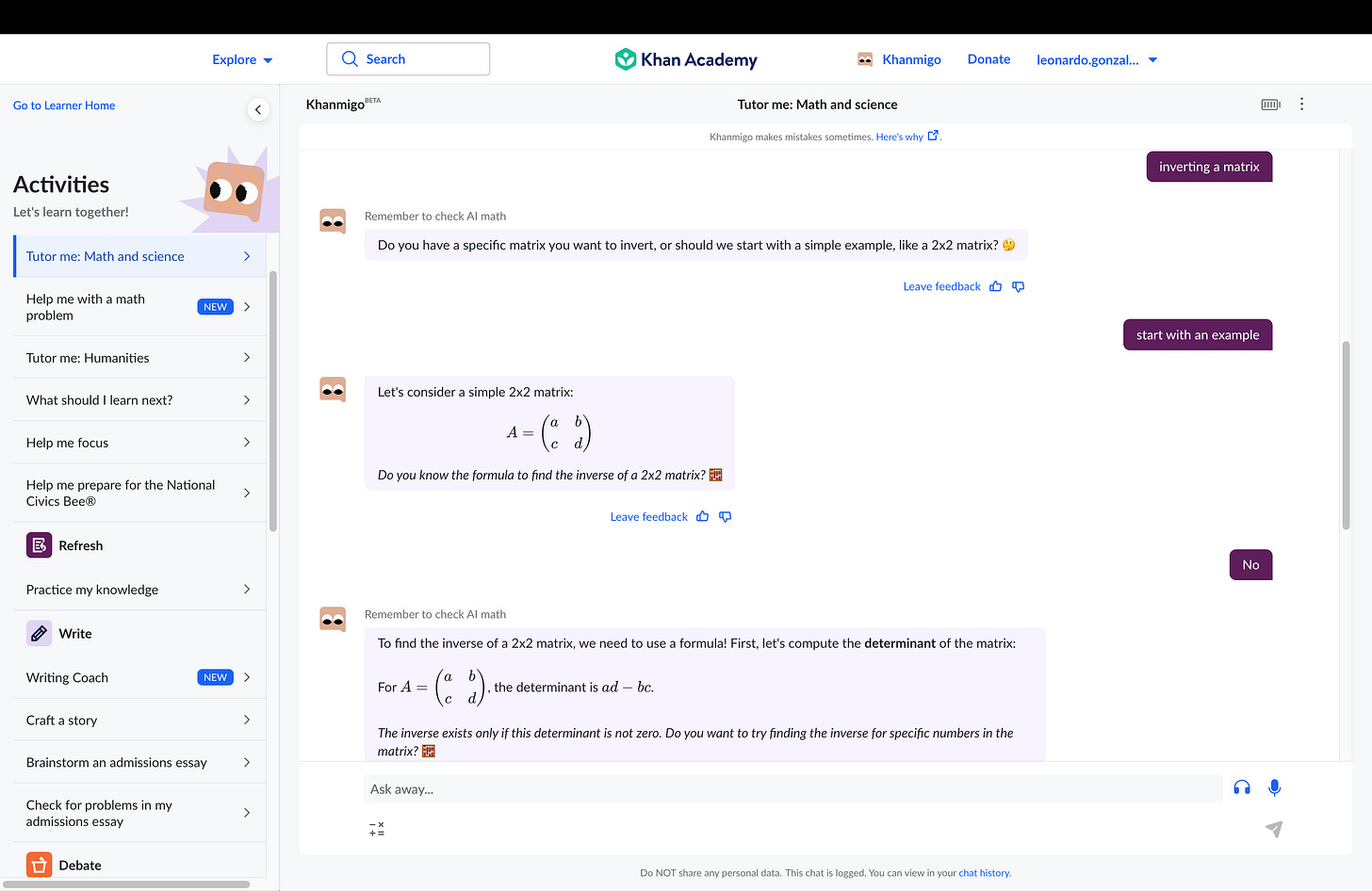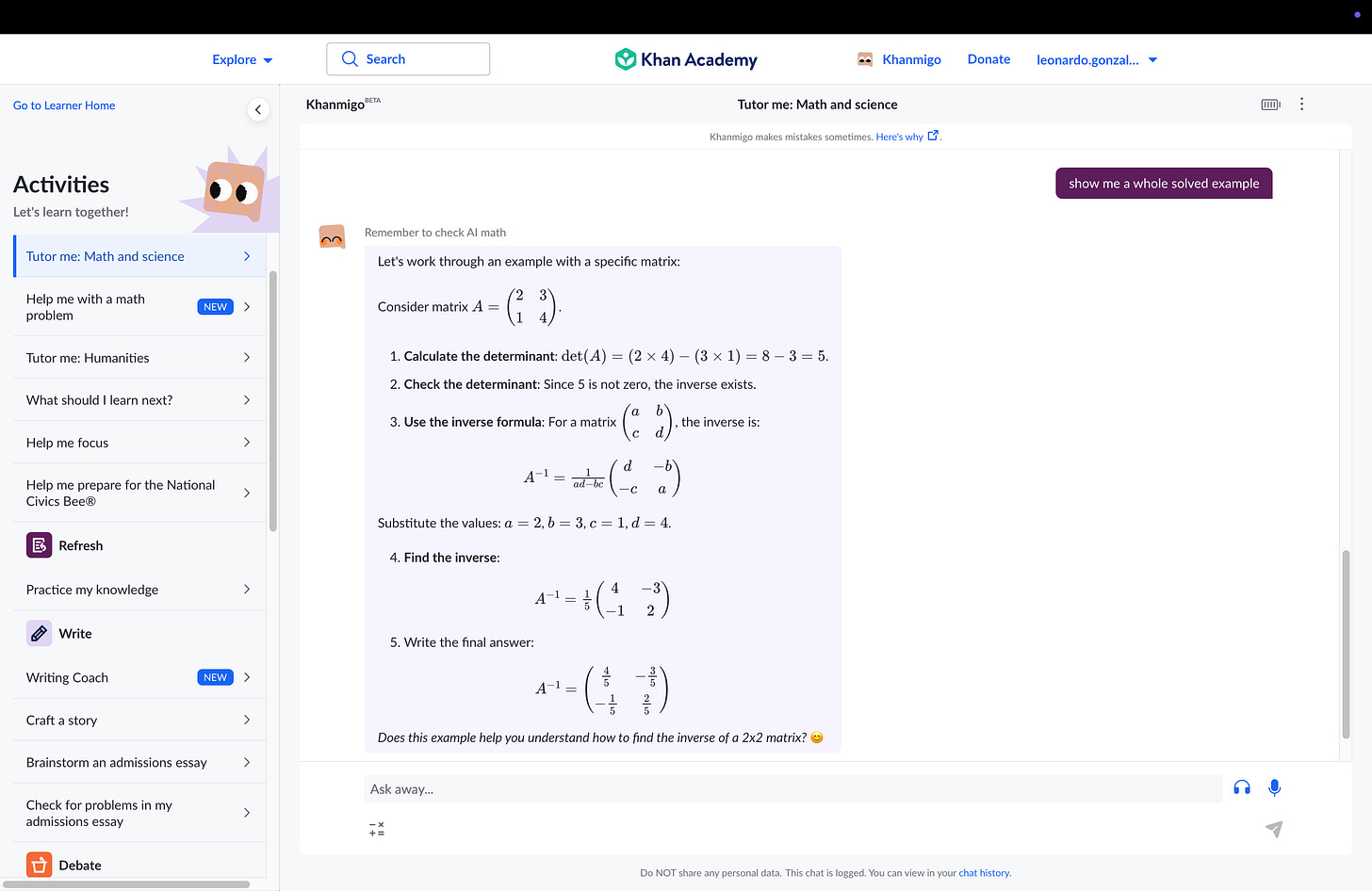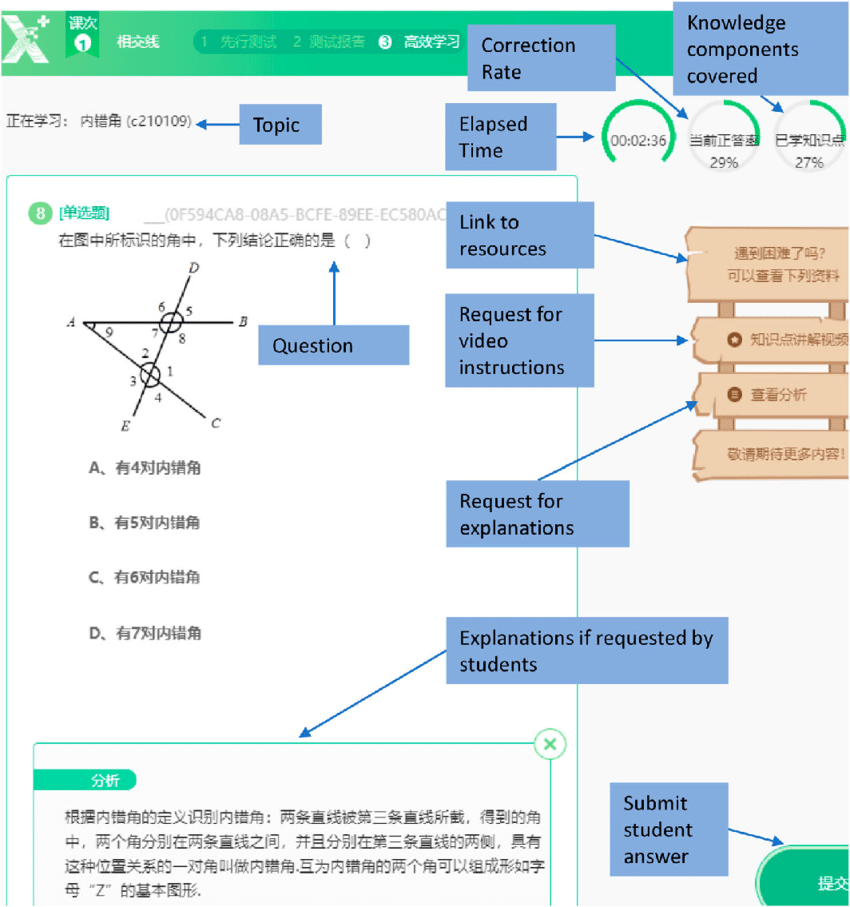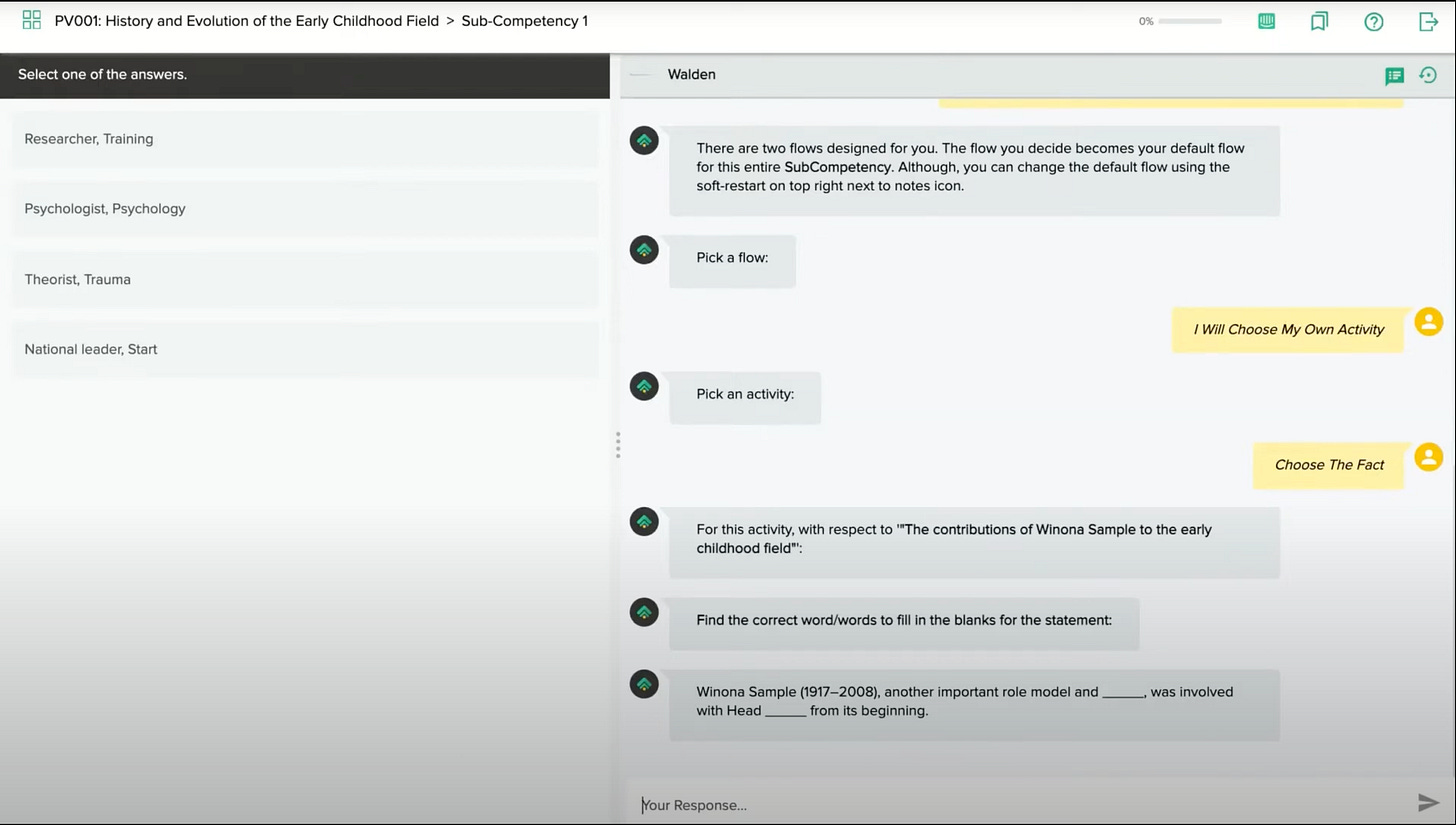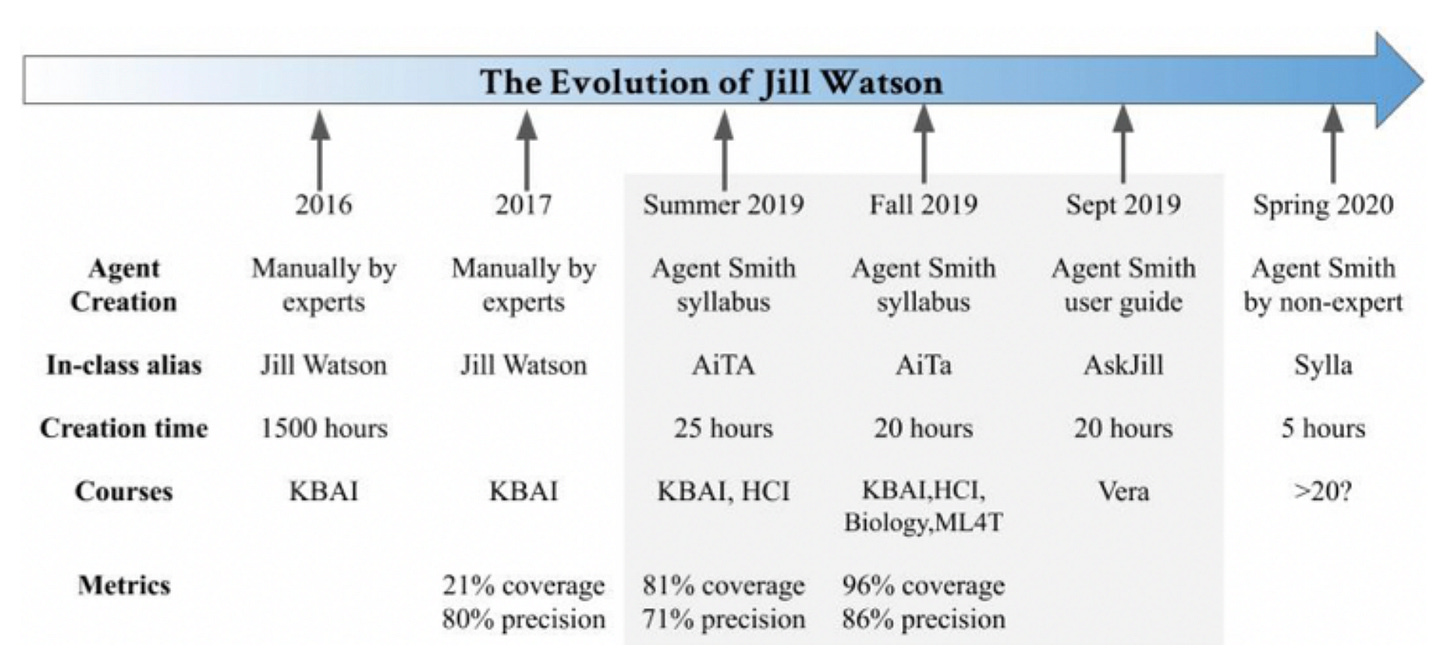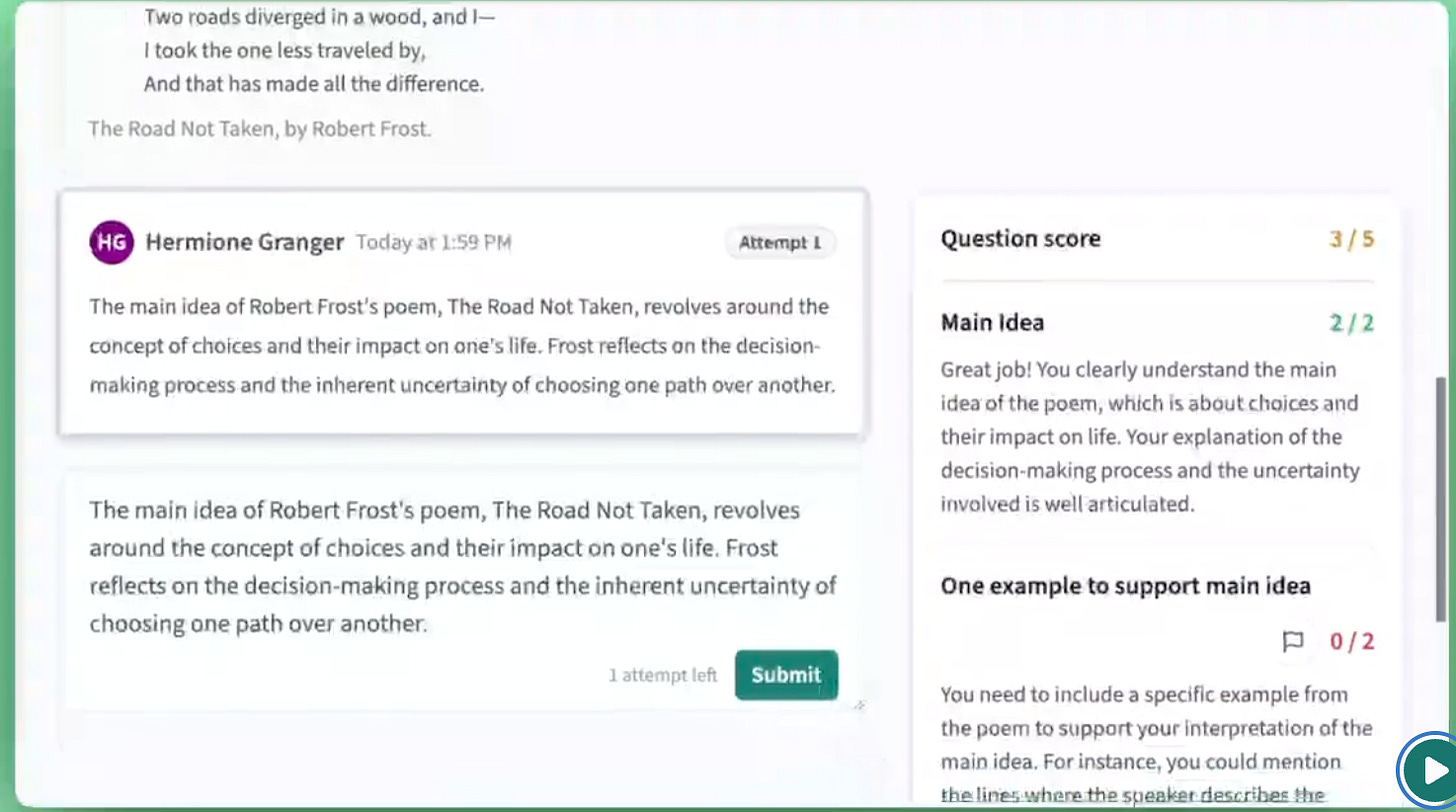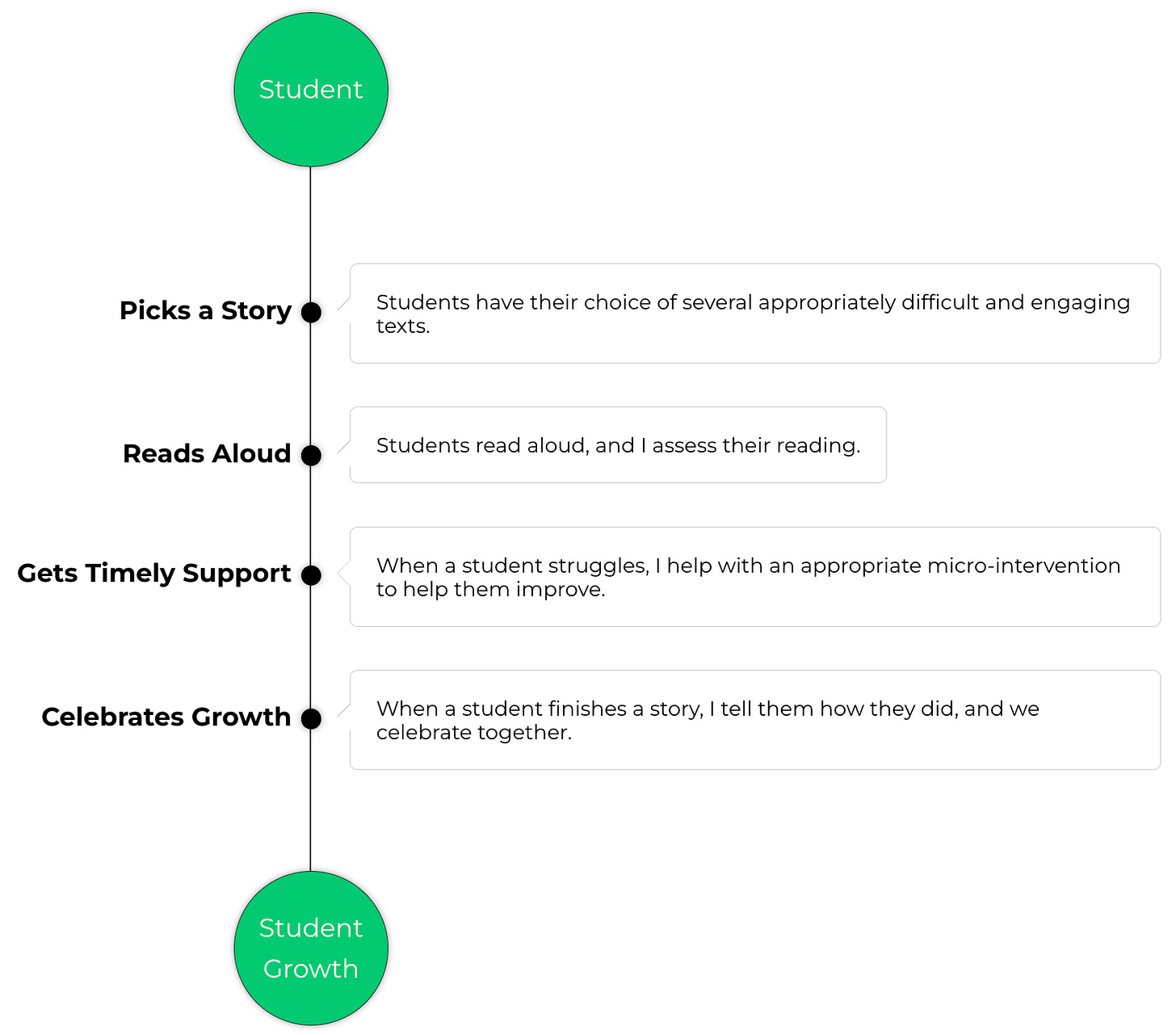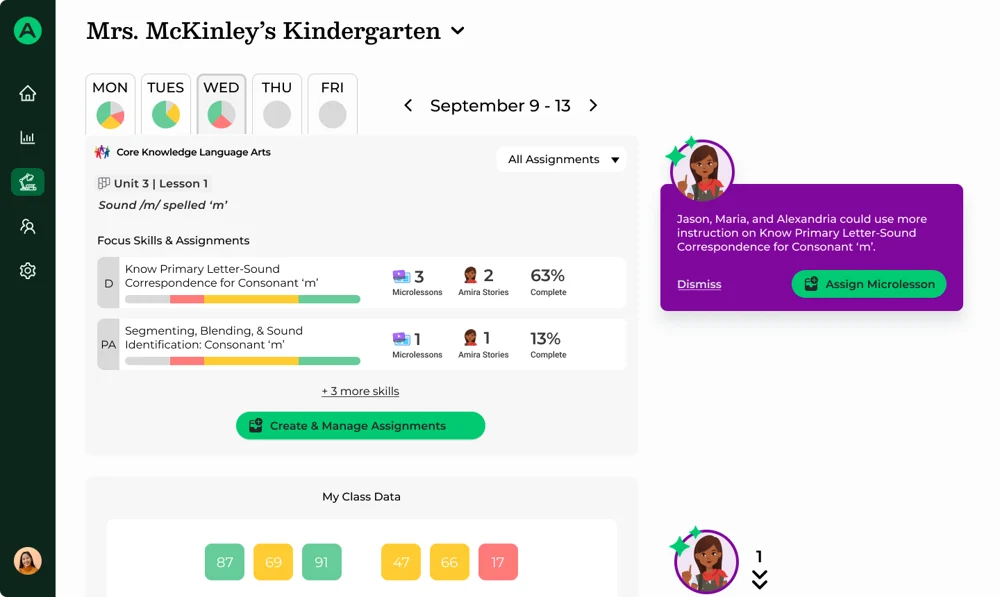Empowering Learners with AI Tutors
The Future of Personalized and Self-Directed Learning
Transforming Education: A Synergistic Approach
Here we explore the intersection of three transformative educational approaches: personalized learning, self-directed learning, and automated AI tutors. As education evolves to meet the needs of diverse learners in a rapidly changing world, these three concepts have emerged as powerful forces for educational innovation. When combined, they create a synergistic approach that has the potential to revolutionize how we think about teaching and learning.
Personalized learning tailors educational experiences to individual learners' needs, preferences, strengths, and challenges. Self-directed learning emphasizes learner autonomy, with individuals taking initiative and responsibility for their own learning process. Automated AI tutors leverage artificial intelligence technologies to provide adaptive, responsive educational support. At their intersection lies a powerful approach that combines individualization, autonomy, and technological advancement to create more effective, engaging, and accessible educational opportunities.
We will examine each concept individually, explore their intersection, and consider the implications for the future of education.
Education at the Crossroads:
Embracing Innovation
Education stands at a crossroads. Traditional educational models, designed for the industrial age, are increasingly inadequate for preparing learners for a complex, rapidly changing world. The convergence of personalized learning, self-directed learning, and automated AI tutors offers a promising path forward.
These three approaches address different but complementary aspects of the educational experience:
Personalized learning focuses on tailoring education to individual needs, recognizing that each learner has unique strengths, challenges, interests, and goals.
Self-directed learning emphasizes learner autonomy and agency, acknowledging that individuals can and should take responsibility for their own learning.
Automated AI tutors leverage advanced technologies to provide adaptive, responsive support that can scale to meet the needs of many learners.
When these approaches converge, they create a powerful synergy that has the potential to transform education. This research explores that intersection, examining how these concepts can work together to create more effective, engaging, and equitable learning experiences.
Personalized Learning:
Tailoring Education to Individual Needs
Definition and Key Principles
Personalized learning is an educational approach that tailors learning experiences to individual students' needs, skills, and interests. It recognizes that each learner has unique strengths, challenges, and preferences, and it seeks to provide educational experiences that are responsive to these individual differences.
Key principles of personalized learning include:
Learner-centered approach: Placing the learner at the center of the educational process, recognizing their unique needs, interests, and goals.
Customized learning paths: Creating individualized learning pathways that allow students to progress at their own pace and in ways that align with their learning styles.
Flexible learning environments: Designing learning environments that can adapt to different learning needs and preferences.
Data-informed instruction: Using data about student performance and engagement to inform instructional decisions.
Mastery-based progression: Allowing students to advance based on demonstrated mastery of content rather than time spent in a classroom.
Historical Development
The concept of personalized learning has evolved significantly over time:
Early 20th century: Progressive educators like John Dewey advocated for more student-centered approaches to education.
Mid-20th century: Individualized instruction gained traction, with approaches like the Keller Plan (Personalized System of Instruction) allowing students to progress at their own pace.
1970s-1980s: Computer-assisted instruction began to offer new possibilities for personalization.
1990s-2000s: The growth of the internet and digital learning resources expanded opportunities for personalized learning.
2010s-present: Advances in data analytics, artificial intelligence, and adaptive learning technologies have further enhanced the potential for personalization.
The Role of AI in Personalizing Education
The integration of AI has been pivotal in advancing personalized learning. Early systems like PLATO (1960s) and SCHOLAR (1970) laid the groundwork for computer-based instruction and intelligent tutoring systems (ITS). PLATO offered programmed learning with rudimentary adaptive feedback, while SCHOLAR taught geography through dialogue, showcasing early natural language interaction. By the 1980s and 1990s, cognitive tutors, such as those developed at Carnegie Mellon, used cognitive science models to provide step-by-step guidance in subjects like algebra, demonstrating significant learning gains approaching the effectiveness of human tutoring.
Current Applications in Education
Personalized learning is being implemented in various ways across educational settings:
K-12 education: Schools are adopting personalized learning approaches through blended learning models, competency-based progression, and learner profiles.
Higher education: Colleges and universities are exploring personalized learning through adaptive courseware, competency-based education programs, and flexible degree pathways.
Corporate training: Organizations are implementing personalized learning approaches to enhance employee development and performance.
Informal learning: Online platforms and resources are providing personalized learning experiences for self-directed learners outside formal educational institutions.
Modern AI Tutors Enhancing Personalization
Recent advances in AI, particularly the rise of large language models (LLMs), have revolutionized personalized learning. Platforms like Khan Academy’s Khanmigo (launched 2023) leverage GPT-4 to engage students in natural language conversations, adapting explanations and hints to individual needs in real-time. Squirrel AI, deployed in over 1,900 learning centers in China by 2019, breaks down curricula into thousands of micro-concepts, using AI to pinpoint and address each student’s knowledge gaps. CENTURY Tech uses machine learning to recommend personalized learning pathways, continuously adjusting content based on student performance. These systems illustrate how AI can provide highly individualized instruction at scale, addressing Bloom’s “2 Sigma Problem” by approximating the benefits of one-on-one tutoring.
Benefits and Challenges
Personalized learning offers numerous benefits:
Improved engagement: When learning experiences align with students' interests and needs, engagement typically increases.
Enhanced achievement: Research suggests that personalized approaches can lead to improved learning outcomes.
Development of agency: Students develop greater autonomy and responsibility for their learning.
Increased equity: Personalized approaches can help address the diverse needs of all learners, potentially reducing achievement gaps.
However, personalized learning also faces challenges:
Implementation complexity: Designing and implementing truly personalized learning experiences can be complex and resource-intensive.
Technology requirements: Many personalized learning approaches rely on technology, which may not be equally accessible to all learners.
Assessment challenges: Traditional assessment methods may not align well with personalized learning approaches.
Teacher preparation: Educators may need significant professional development to effectively implement personalized learning.
Risk of overreliance on AI: While AI tutors can provide significant learning gains, there is a risk that students may become overly dependent on AI, potentially hindering the development of independent learning skills, as evidenced by a field experiment with GPT-4-based tutors where math gains partially regressed after AI removal.
Self-Directed Learning:
Empowering Learner Autonomy
Definition and Key Principles
Self-directed learning (SDL) is an educational approach where learners take initiative and responsibility for their own learning process. According to the University of Waterloo's Centre for Teaching Excellence, self-directed learning is a process where students independently plan, implement, and evaluate their own study.
Key principles of self-directed learning include:
Learner autonomy: Students have significant control over their learning goals, resources, and processes.
Intrinsic motivation: Learning is driven by internal motivation rather than external rewards or pressures.
Self-regulation: Learners develop the ability to monitor and adjust their learning strategies.
Metacognition: Students reflect on their learning process and develop awareness of how they learn best.
Resource utilization: Learners identify and leverage various resources to support their learning goals.
The Alliance for Self-Directed Education offers a more philosophical definition: "Self-directed education is education that derives from the self-chosen activities and life experiences of the learner, whether or not those activities were chosen deliberately for the purpose of education." This definition emphasizes that learning can happen through everyday activities driven by curiosity, playfulness, and sociability.
Historical Development
Self-directed learning has a rich historical background:
1800s: In England, terms such as "self-help," "self-improvement," and "self-education" were used, reflecting early concepts of self-direction.
1960s: Cyril Houle published "The Inquiring Mind," making visible self-directed learning as an important part of adult learning.
1960s-1970s: Allen Tough provided a comprehensive description of self-directed learning through his research on "learning projects."
1970s: Malcolm Knowles introduced the concept of andragogy and published work on self-directed learning.
1980s: The concept attained "something of a cult status" in adult education literature, according to Candy.
1986: The International Society for Self-Directed Learning began holding annual symposiums dedicated to the promotion of self-directed learning.
Key Components and Process
The University of Waterloo outlines a four-step process for self-directed learning:
Assess Readiness to Learn: Students conduct a self-evaluation of their current situation, study habits, family situation, and support network. Signs of readiness include being autonomous, organized, self-disciplined, able to communicate effectively, and able to accept constructive feedback and engage in self-evaluation.
Set Learning Goals: Communication of learning goals between a student and the advising instructor is critical. Learning contracts are often used to formalize goals, structure, timeline, resources, grading procedures, and feedback mechanisms.
Engage in the Learning Process: Students need to understand themselves as learners and adopt a "deep approach" to studying, which involves transformation rather than mere reproduction of knowledge. This approach is about understanding ideas for yourself, applying knowledge to new situations, and learning more than is required for unit completion.
Evaluate Learning: Students must be able to engage in self-reflection and self-evaluation of their learning goals and progress. This involves regularly consulting with advisors, seeking feedback, and reflecting on achievements.
Applications in Education
Self-directed learning can be applied in various educational contexts:
Formal Education: Within classroom settings where students have significant input into learning goals, resources, and assessment methods.
Experiential Learning: When students encounter unfamiliar situations and must find appropriate resources to learn about them.
Co-curricular Activities: As students learn about topics of interest outside formal curriculum.
Adult Education: Particularly suited to adult learners who bring life experience and specific learning goals.
Alternative Education Models: Such as unschooling or democratic schools where learners have substantial control over their education.
AI Tutors Supporting Self-Directed Learning
AI tutors enhance self-directed learning by providing on-demand resources and guidance. Khanmigo, for example, is designed to encourage students to find answers themselves by offering hints and Socratic questioning rather than direct solutions, fostering autonomy. CENTURY Tech, used in schools adopting self-directed models during the 2020 pandemic, recommends content while allowing students to choose when to engage, promoting self-paced learning. In corporate settings, learning experience platforms (LXPs) like Docebo use AI to recommend training content tailored to employees’ roles and interests, supporting self-directed upskilling. These tools illustrate how AI can empower learners to take charge of their educational journey while providing personalized support.
Benefits and Challenges
Benefits:
Increases learners' motivation, feelings of control, confidence, and belief in themselves
Supports unlimited learning potential and creativity
Develops skills necessary for lifelong learning
Allows learning to be tailored to individual interests, needs, and goals
Promotes autonomy, mastery, and purpose in the educational process
Challenges:
Requires appropriate scaffolding and structure for learners new to this model
Demands development of underlying soft skills for students to be successful
Presents challenges for both learners and educators in implementation
Requires proactive planning for potential challenges during course design
May be difficult to implement in traditional educational settings
AI Tutors and Educational Technology:
Leveraging Artificial Intelligence for Learning
Historical Development
The concept of intelligent tutoring systems (ITSs) can be traced back to 1970. These early systems aimed to provide computer-based learning with some level of personalization. However, the recent explosion of large language models like ChatGPT has dramatically increased the accessibility and capabilities of AI tutoring systems.
Key milestones include:
1970s: Early conceptualization of intelligent tutoring systems, with systems like SCHOLAR demonstrating dialogue-based tutoring.
2016: Georgia Tech unveiled "Jill Watson," an AI teaching assistant created in collaboration with IBM.
2021: Walden University introduced "Julian," a dynamic AI tutor developed with Google.
2023-2025: Widespread adoption of AI tutors in K-12 and higher education settings, with platforms like Khanmigo gaining prominence.
Core Technologies and Approaches
Modern AI tutoring systems leverage several key technologies:
Natural Language Processing (NLP): NLP enables AI tutors to understand and respond to student questions in natural language, creating more intuitive interactions. NLP can be used as a chatbot to interact with students, provide feedback, and implement necessary learning interventions.
Machine Learning (ML): ML algorithms allow AI tutors to analyze student performance data, identify patterns, and adapt instruction accordingly. ML can be used to perform learning analytics activities and predict student performance.
Computer Vision and Emotion Recognition: Some advanced AI tutoring systems use image recognition to identify students' facial expressions, gestures, or emotions, providing insights that can inform teaching approaches. This technology helps systems understand not just what students know, but how they feel during the learning process.
Adaptive Learning Algorithms: These algorithms customize the learning experience based on student performance, adjusting difficulty levels, providing additional practice, or offering alternative explanations when needed.
Technical Innovations in AI Tutoring
Recent advancements include the integration of deep learning and knowledge graphs. Squirrel AI uses a fine-grained knowledge graph to break down curricula into micro-concepts, enabling precise personalization. Carnegie Learning’s Cognitive Tutor employs Bayesian Knowledge Tracing (BKT) to model student mastery, achieving 72% prediction accuracy, while Deep Knowledge Tracing (DKT) using neural networks reaches 81%.
The rise of LLMs has enabled conversational tutors like Khanmigo, which adapt dynamically to student queries, shifting from structured, rule-based systems to flexible, learner-driven interactions.
There are some advances in learning-specific language models, notably Google’s LearnLM which is “an experimental task-specific model that has been trained to align with learning science principles” when provided with a targeted system prompt. Interestingly, it can be used in a normal chat interface (via AI Studio) to create a free interactive content delivery and practice question tutoring experience – without the need for any software development. I’ve created this system prompt which has proven useful for interactive learning sessions ranging from a few minutes to a few hours. Other powerful models like Grok 3 (via grok.com) and Llama 4 (via meta.ai) have also proven to perform quite well with the same prompt.
Major Platforms and Implementations
Several notable AI tutoring platforms have emerged:
Khanmigo (Khan Academy): Khanmigo is Khan Academy's AI-powered teaching assistant and tutor. According to their website, it provides "on-demand AI-powered support for education" and is "built for educators by educators." Khanmigo offers support for teachers, students, and parents, with specific features for writing instruction, homework help, and lesson planning. It has received recognition as a top-rated AI-for-education tool.
Trying it out, it appears to act similarly to ChatGPT with some custom instructions to work through problems one step at a time and provide guidance or questions instead of giving the full solution right away. Even for explaining something for the first time, it is careful not to show a full worked example unless prompted and before first asking about any knowledge the student can provide.Although it has an audio interface, it is not truly multimodal in the visual sense. There is no option to upload or display images. It does not attempt to find or generate relevant images, but it does have access to articles and other resources with related multimedia.
Squirrel AI: Another development has been the integration of knowledge graphs and learning analytics for personalization at scale. For example, China’s Squirrel AI (a pioneer since mid-2010s) breaks down curricula into thousands of micro-concepts and uses AI to pinpoint each student’s knowledge gaps. Its system continuously refines a student model as the learner progresses, deciding the optimal next topic to present. By 2019 Squirrel AI had deployed this model in over 1,900 learning centers across China to provide after-school tutoring in a blended format (AI software plus human facilitators). Such systems leverage big data – millions of student interactions – to improve adaptive accuracy. The past few years have also seen deep knowledge tracing algorithms (applying deep neural networks to model student knowledge states) and reinforcement learning approaches that enable AI tutors to “learn” the best teaching policies through trial and error. These techniques improve how well tutors personalize sequences of instruction, often invisibly in the background of learning apps.
CENTURY Tech: Crucially, recent AI tutors place greater emphasis on self-directed learning. Influenced by the pandemic-driven surge in online learning, many platforms built features to let learners drive their own progress. For instance, the AI-powered platform CENTURY Tech was used in 2020 by schools adopting self-directed learning models – students would independently navigate AI-recommended tasks, while teachers acted as guides on the side. CENTURY’s AI continuously recommends content based on a learner’s past performance and behavior, but learners can choose when to tackle those tasks, review their own dashboards, and take ownership of pacing. The platform’s philosophy explicitly “encourag[es] students to take more agency with their learning,” enabling more independent learning habits.
Julian (Walden University): As described in the EdTech Magazine article, Julian is an AI tutor developed by Walden University in collaboration with Google. Unlike earlier AI tutors that followed preset scripts, Julian was designed to be "truly dynamic" and "truly unscripted." It can ingest course content independently, extract key concepts, and foster genuine tutoring sessions by generating its own questions and assessing student answers. Julian was initially implemented in courses like early childhood education and sociology, where answers aren't simply right or wrong.
This was built in 2021 with BERT, before the advent of GPT-4. It is unclear if it is currently maintained or updated with much more powerful recent models.Jill Watson and Related Systems (Georgia Tech): Georgia Tech's pioneering AI teaching assistant, Jill Watson, has evolved into a family of tools including AskJill and Agent Smith. The university has established the National AI Institute for Adult Learning and Online Education (AI-ALOE) with a $20 million grant from the National Science Foundation. Agent Smith is particularly notable for its ability to clone Jill Watson AI tutors for different courses and classrooms, potentially enabling widespread adoption.
Class Companion and MagicSchool AI: These platforms are being used in high school settings. Class Companion scores students' writing, while MagicSchool AI provides feedback, allowing students to revise their work before final submission. These tools have "revolutionized" what teachers can assign to help students prepare for exams like AP tests.
Amira Learning: Amira Learning, as described in the Education Week article, helps K-6 students with reading instruction. It records students as they read, provides immediate feedback on pronunciation and comprehension, and offers teachers insights into students' reading levels along with tailored lessons.
Comparison of Major AI Tutor Platforms
AI tutors vary in their balance of personalization and autonomy:
Squirrel AI: Focuses on structured personalization using a knowledge graph and adaptive sequencing. It offers limited learner choice in content order, ideal for foundational skills remediation.
Khanmigo: Emphasizes learner-driven interactions with GPT-4, allowing students to ask open-ended questions and receive Socratic hints, fostering high autonomy.
CENTURY Tech: Recommends personalized pathways but allows students to choose when to engage, supporting self-paced learning in formal settings.
Benefits of AI Tutors
AI tutoring systems offer numerous advantages for education:
For Students:
Personalized Learning: AI tutors can adapt to individual learning styles, paces, and preferences.
Immediate Feedback: Students receive instant responses and corrections, accelerating the learning process.
24/7 Availability: Learning support is accessible at any time, accommodating different schedules and allowing for learning outside traditional classroom hours.
Reduced Anxiety: Some students feel more comfortable asking questions to an AI tutor than to a human teacher, particularly for basic or repeated questions.
Increased Practice Opportunities: AI tutors allow students to practice skills like writing more frequently without increasing teacher workload.
For Educators:
Reduced Workload: AI tutors can handle routine questions and provide basic feedback, freeing teachers to focus on more complex aspects of education.
Data-Driven Insights: Teachers receive detailed analytics about student performance, helping identify areas where additional support is needed.
Enhanced Efficiency: The EdTech Magazine article notes that AI tutors are "enabling students to get the most out of their education and allowing faculty members to focus on the areas where they can best share their expertise."
Support for Diverse Learners: AI tutors can help teachers provide differentiated instruction for students with varying needs, including multilingual students as mentioned in the Education Week article.
Challenges and Limitations
Despite their potential, AI tutors face several challenges:
Technical Challenges:
Accuracy and Reliability: AI systems may provide incorrect information or fail to understand complex questions.
Limited Understanding of Context: Current AI tutors may struggle with nuanced or context-dependent learning situations.
Integration with Existing Systems: Implementing AI tutors within established educational technology ecosystems can be challenging.
Pedagogical Concerns:
Depth of Learning: Questions exist about whether AI tutors can foster deep understanding rather than surface-level knowledge.
Critical Thinking Development: Some educators worry that AI tutors might not adequately promote critical thinking skills.
Overreliance on Technology: Students might become dependent on AI assistance rather than developing independent learning skills.
Ethical and Social Considerations:
Privacy and Data Security: The SpringerOpen article highlights "issues related to privacy and data security" as challenges in using AI systems in education.
Bias and Fairness: AI systems may reflect or amplify existing biases in educational content or assessment.
Curriculum Control: When incorporating technology from large companies, questions arise about who is setting the curriculum and who is dictating pedagogy.
The Intersection: How AI Tutors Enable Personalized and Self-Directed Learning
The convergence of personalized learning, self-directed learning, and AI tutors creates a powerful synergy that has the potential to transform education. This intersection represents a new paradigm that combines the individualization of learning experiences, learner autonomy, and advanced technology.
How AI Tutors Enable Personalized Learning
AI tutors excel at creating truly personalized learning experiences through several mechanisms:
Adaptive Learning Pathways:
AI tutors can create dynamic learning pathways for students, adaptable to their unique strengths and weaknesses. This adaptivity works through:
Real-time assessment and adjustment: AI systems analyze student responses and automatically adjust the challenge level based on demonstrated mastery.
Pace customization: Students can progress at their optimal pace, with more methodical approaches for those who need additional time and more complex material for those who grasp concepts quickly.
Comprehensive pre-assessments: AI tutors can conduct thorough pre-assessments to identify areas of proficiency and knowledge gaps, using this data to build customized study plans.
Personalized Content and Resources:
AI tutors can provide content and resources tailored to individual learners:
Learning style adaptation: AI tutors can tailor the learning experience to different learning styles, providing audio explanations for auditory learners, visual aids for visual learners, and interactive activities for kinesthetic learners.
Targeted practice: AI can generate personalized practice questions and quizzes that directly address the student's knowledge gaps.
Custom feedback: AI tutors provide immediate, personalized feedback on student work, highlighting specific areas for improvement.
Data-Driven Insights:
AI tutors leverage data analytics to enhance personalization:
Learning pattern recognition: By analyzing vast amounts of student data, AI systems can identify patterns in how individual students learn most effectively.
Progress tracking: AI tutors monitor student progress over time, adjusting learning pathways based on changing needs and achievements.
Predictive analytics: Advanced AI systems can predict areas where students might struggle in the future, allowing for proactive intervention.
How AI Tutors Support Self-Directed Learning
AI tutors enhance self-directed learning by providing the support and resources learners need to take control of their educational journey:
Empowering Learner Autonomy:
AI tutors support learner autonomy in several ways:
Facilitating independent learning: Personalized and adaptive instruction allows learners to take greater control of their educational journey.
Fostering self-regulation: AI tutors help students develop metacognitive skills by encouraging reflection on their learning process and progress.
Supporting goal-setting: Advanced AI systems assist learners in setting realistic, achievable learning goals and tracking progress toward those goals.
Providing Resources and Guidance:
AI tutors serve as valuable resources for self-directed learners:
24/7 availability: As highlighted in the QuadC article, "AI-powered tutors are available 24/7, offering students immediate assistance whenever they need it." This constant availability supports the flexible, self-paced nature of self-directed learning.
Resource curation: AI helps learners find relevant resources based on their interests and learning goals, as mentioned in the Medium article: "Based on their interests and learning goals, the technology can help students find books, papers, and videos that are relevant to them."
Scaffolding support: AI tutors provide appropriate scaffolding, offering more support when needed and gradually reducing assistance as learners develop mastery.
Promoting Learner Engagement and Motivation:
AI tutors enhance engagement in self-directed learning:
Personalized challenges: By providing appropriately challenging content, AI tutors keep learners in their "zone of proximal development," maintaining motivation and engagement.
Gamification elements: Many AI tutoring systems incorporate gamification to increase motivation and engagement in self-directed learning activities.
Progress visualization: AI systems visualize learning progress, helping self-directed learners see their advancement and stay motivated.
Research on AI Tutors and Self-Directed Learning
Studies show that AI tutors can foster self-regulated learning behaviors when designed thoughtfully. For instance, combining open learner models (visual displays of mastery levels) with AI feedback enhances self-regulation, as students use these tools to plan and monitor their learning. Khanmigo’s Socratic approach promotes autonomy by prompting students to explain their reasoning. However, a field experiment with GPT-4 tutors found that while math performance improved by 48%–127%, gains regressed post-AI removal, indicating potential dependency. Designers mitigate this by encouraging independent problem-solving and reflection.
Transformative Educational Approaches at the Intersection
The convergence of personalized learning, self-directed learning, and AI tutors is creating new educational paradigms that transform traditional approaches.
Shifting Educational Power Dynamics:
This intersection is reshaping educational power dynamics:
Democratization of education: Self-directed learning empowered by AI greatly benefits the student. It decentralizes power and revolutionizes how schools and EdTech companies operate.
Teacher role evolution: The EducationNC article describes "the intersection of personalized learning and AI heralds a new era in education — one in which teachers become facilitators of personalized journeys, and students are empowered with greater autonomy and choice."
Institutional adaptation: Traditional educational institutions may need to adapt to this changing paradigm, as their educational practices and structures may become outdated.
Enhanced Learning Experiences:
The intersection creates richer learning experiences:
Immersive learning environments: AI can create simulated environments for applied learning, as the Medium article notes: "The technology can simulate real-world scenarios, providing learners with opportunities to practice and apply their knowledge and skills in a safe and engaging way."
Multimodal learning: AI tutors can present information in various formats (text, audio, visual, interactive), catering to different learning preferences and enhancing comprehension.
Continuous feedback loops: The combination of personalization, self-direction, and AI creates powerful feedback loops that continuously refine the learning experience.
Addressing Educational Challenges:
This intersection helps address persistent educational challenges:
Accessibility: AI-enhanced self-directed learning can break down geographical barriers to education.
Scalability: The approach allows for personalized, self-directed learning at scale, potentially addressing teacher shortages and educational inequities.
Time efficiency: For educators, AI can reduce workload on routine tasks.
Technical Underpinnings
The technical foundation of this intersection includes advanced machine learning models like Bayesian Knowledge Tracing (BKT) and Deep Knowledge Tracing (DKT), used in platforms like Carnegie Learning’s MATHia, and knowledge graphs in Squirrel AI. Data collection involves continuous mining of performance metrics, processed through cloud-based architectures (e.g., ScootPad) to adapt learning paths in real-time, enhancing both personalization and autonomy. Modern evolution will rely heavily on multimodal and reasoning LLMs.
Challenges and Considerations
Despite its potential, the intersection of personalized learning, self-directed learning, and AI tutors presents several challenges and considerations that must be addressed for successful implementation.
Technical and Implementation Challenges:
Data privacy and security: The collection and analysis of student data raise important privacy concerns that must be addressed through robust policies and technical safeguards. K-12 systems comply with FERPA and COPPA, using AES-256 encryption (88% compliance rate), while enterprise systems align with GDPR (94% compliance).
Algorithm bias: AI systems may reflect or amplify existing biases in educational content or assessment, potentially disadvantaging certain groups of learners. Ongoing monitoring and adjustment of AI systems is necessary to mitigate bias.
Integration with existing systems: Implementing these approaches within established educational technology ecosystems can be challenging, requiring careful planning and potentially significant infrastructure investments.
Technical reliability: AI systems may experience technical issues or limitations that could disrupt the learning process if not properly addressed.
Pedagogical Concerns:
Balance of structure and autonomy: Finding the right balance between providing structure and promoting autonomy remains a challenge in implementing self-directed, personalized learning with AI.
Depth of learning: Questions exist about whether AI tutors can foster deep understanding rather than surface-level knowledge, particularly for complex concepts that require nuanced understanding.
Human connection: Maintaining meaningful human interaction in AI-enhanced learning environments is crucial.
Assessment alignment: Traditional assessment methods may not align well with personalized, self-directed learning approaches, necessitating new approaches to evaluating learning outcomes.
Ethical and Social Considerations:
Curriculum control: Questions arise about who controls the curriculum and pedagogical approaches in AI-driven systems, with potential concerns about corporate influence on educational content.
Overreliance on technology: There's a risk of becoming too dependent on AI systems, potentially undermining the development of certain learning skills and creating vulnerability to technical failures.
Cultural responsiveness: AI systems must be designed to be culturally responsive and inclusive, recognizing and respecting diverse perspectives and approaches to learning.
Future Directions
The intersection of personalized learning, self-directed learning, and AI tutors continues to evolve, with several promising directions for future development.
Technological Advancements:
Multimodal generation: Recent advances in multimodal models like Gemini 2.5, OpenAI GPT-4o, and Llama 4 will open the way toward customized creation of visual content. Currently they can be used to produce media at scale, directly or indirectly via code generation (see our Generating Engaging Visuals for Education article). These could be delivered in structure curriculum on as par of RAG pipelines to feed relevant content to the student at appropriate times. As these models improve, we could more reliably use them to generate visual media on-demand, for a truly customized experience unlike anything done so far.
Improved AI capabilities: Advances in the reasoning power and efficiency of LLMs will enhance the capabilities of AI tutors, making them more responsive, accurate, and nuanced in their interactions with learners.
More sophisticated personalization: Future systems will likely offer even more nuanced personalization based on a wider range of learner characteristics, including emotional states, cultural backgrounds, and learning preferences. Emotionally adaptive tutors may detect frustration and adjust accordingly.
Enhanced interactivity: Improvements in voice recognition, gesture recognition, and other interface technologies will make AI tutors more intuitive and engaging, potentially incorporating virtual or augmented reality elements and multimodal interactions.
Increased interoperability: Future AI tutoring systems may be more easily integrated with other educational technologies and systems, creating more seamless learning experiences.
Pedagogical Innovations:
New instructional models: The intersection will likely spawn innovative instructional models that blend the best aspects of personalization, self-direction, and AI support, potentially transforming how we conceptualize teaching and learning.
Refined assessment approaches: New ways of assessing learning that align with personalized, self-directed approaches will continue to develop, potentially leveraging AI for more authentic and meaningful assessment.
Expanded application areas: These approaches will likely expand into new subject areas and educational contexts, including areas traditionally considered difficult to teach through technology, such as creative arts or physical education.
Enhanced collaborative learning: Future developments may better integrate collaborative learning with personalized, self-directed approaches, recognizing the importance of social interaction in the learning process.
Systemic Changes:
Educational policy evolution: As these approaches demonstrate effectiveness, educational policies may evolve to better accommodate and support them, potentially including changes to accreditation, funding, and accountability systems.
Institutional transformation: Educational institutions may undergo significant transformations to embrace these new approaches, potentially leading to new organizational structures and operational models.
Workforce preparation: These approaches may help address the need for "reskilling or upskilling" in response to automation and changing workforce demands, potentially creating new pathways for lifelong learning.
Research and evaluation: Ongoing research will be essential to understand the impact of these approaches on learning outcomes, equity, and other important educational goals, informing future development and implementation.
The Future of Learning: Integrating Autonomy, Personalization, and AI
The convergence of personalized learning, self-directed learning, and automated AI tutors holds transformative potential for education, blending individualized experiences, learner autonomy, and cutting-edge technology to create more effective, engaging, and accessible opportunities. The future lies not in pitting human teachers against AI or structure against autonomy, but in integrating their strengths to craft a more responsive, inclusive, and empowering learning landscape.
Recent and emerging advances in multimodal and reasoning models are set to supercharge AI tutors, significantly boosting their ability to adapt to diverse learners and empower self-directed progress. Though challenges in technology, pedagogy, ethics, and equity persist, thoughtful implementation—mindful of privacy, bias, and human oversight—can harness these innovations to tackle longstanding educational hurdles.
References
Alliance for Self-Directed Education. (n.d.). What Is Self-Directed Education? Alliance for Self-Directed Education. https://www.self-directed.org/sde/
Bersin, J. (2024, February 15). Autonomous Corporate Learning Platforms: Arriving Now, Powered by AI. Josh Bersin Company. https://joshbersin.com/2024/02/autonomous-corporate-learning-platforms-arriving-now-powered-by-ai/
Bloom, B. (1984) The 2 Sigma Problem: The Search for Methods of Group Instruction as Effective as One-to-One Tutoring. Educational Researcher. https://www.jstor.org/stable/1175554
Carnegie Mellon University. (2019, April 23). CMU, Yixue Education Inc. Announce AI Research Project for Adaptive K-12 Education. Carnegie Mellon University School of Computer Science. https://www.cs.cmu.edu/news/2019/cmu-yixue-education-inc-announce-ai-research-project-adaptive-k-12-education
CENTURY Tech. (n.d.). How Can Personalised Learning Accelerate Student Progress? CENTURY Tech. https://www.century.tech/news/how-can-personalised-learning-accelerate-student-progress/
Christopher, J. (2023, October 18). Self-Managed Learning and AI: A New Way to Learn. Medium. https://jameschris.medium.com/self-managed-learning-and-ai-a-new-way-to-learn-43948bceda52
DreamBox Learning. (2024, May 30). Reading Plus: System Requirements. DreamBox Learning Help Center. https://dreamboxlearning.zendesk.com/hc/en-us/articles/29879358399379-Reading-Plus-System-Requirements
EdTech Magazine. (2022, September 23). The Future of AI Tutors in Higher Education. EdTech Magazine. https://edtechmagazine.com/higher/article/2022/09/future-ai-tutors-higher-education
Education Next. (2025, Spring). AI Tutors: Hype or Hope for Education? Education Next Forum. https://www.educationnext.org/ai-tutors-hype-or-hope-for-education-forum/
Education Week. (2025, February 14). The New Teachers' Aides: AI Tutors. Education Week. https://www.edweek.org/technology/the-new-teachers-aides-ai-tutors/2025/02
EducationNC. (2024, February 26). An Educator's Journey Through Personalized Learning to AI Integration. EducationNC. https://www.ednc.org/educators-journey-personalized-learning-artificial-intelligence-ai-integration/
EducationView Media. (2021, December 24). Global Development of AI-Based Education. EducationView Media. https://www.educationview.media/uploads/resources/resources/232021124241AM_Resource_GlobalDevelopmentOfAiBasedEducation.pdf
El Hadbi, A., et al. (2024). Design and Implementation of an Adaptive Tutoring System for Enhanced E-Learning. Data and Metadata. http://dx.doi.org/10.56294/dm2025469
Federal Trade Commission. (n.d.). Children’s Online Privacy Protection Rule: A Six-Step Compliance Plan for Your Business. Federal Trade Commission. https://www.ftc.gov/system/files/ftc_gov/pdf/p195404_coppa_reg_review.pdf
Future of Privacy Forum. (2024, October). Artificial Intelligence & Education: Legal Compliance Considerations. Future of Privacy Forum. https://fpf.org/wp-content/uploads/2024/10/Ed_AI_legal_compliance.pdf_FInal_OCT24.pdf
Institute of Data. (n.d.). The Evolution of AI in Education: Past, Present, and Future. Institute of Data. https://teachflow.ai/the-evolution-of-ai-in-education-past-present-and-future
Khan Academy. (n.d.). Meet Khanmigo: Khan Academy's AI-Powered Teaching Assistant & Tutor. Khan Academy. https://khanmigo.ai/
Khan Academy. (n.d.). Khanmigo for Learners: Always-Available Tutor, Powered by AI. Khan Academy. https://khanmigo.ai/learners
Khan Academy. (2023, March 14). Harnessing AI So That All Students Benefit: A Nonprofit Approach for Equal Access. Khan Academy Blog. https://blog.khanacademy.org/harnessing-ai-so-that-all-students-benefit-a-nonprofit-approach-for-equal-access/
Koedinger, K. R., & Aleven, V. (2015). Introduction to Demonstration of Carnegie Learning’s MATHia. Educational Data Mining Proceedings. https://www.educationaldatamining.org/EDM2015/proceedings/demo633-634.pdf
Knewton. (2015, September 2). The Knewton Platform: A White Paper. Profijt. https://www.profijt.nu/wp-content/uploads/2015/09/20150902-White-paper-The-Knewton-Platform.pdf
Lin, C. C., Huang, A. Y. Q., & Lu, O. H. T. (2023). Artificial Intelligence in Intelligent Tutoring Systems Toward Sustainable Education: A Systematic Review. Smart Learning Environments. https://slejournal.springeropen.com/articles/10.1186/s40561-023-00260-y
Loeng, S. (2020). Self-Directed Learning: A Core Concept in Adult Education. Education Research International. https://onlinelibrary.wiley.com/doi/10.1155/2020/3816132
Microsoft. (n.d.). Microsoft Education AI Toolkit. Microsoft Corporation. https://cdn-dynmedia-1.microsoft.com/is/content/microsoftcorp/microsoft/final/en-us/microsoft-product-and-services/microsoft-education/downloadables/Microsoft-Education-AI-Toolkit1.pdf
Microsoft Learn. (n.d.). Natural Language Processing Technology Choices. Microsoft Azure Architecture Center. https://learn.microsoft.com/en-us/azure/architecture/data-guide/technology-choices/natural-language-processing
Mishra, P. (2025, March 14). Control vs. Agency: Exploring the History of AI in Education. Punya Mishra’s Blog. https://punyamishra.com/2025/03/14/control-vs-agency-exploring-the-history-of-ai-in-education/
Park University. (n.d.). AI in Education: The Rise of Intelligent Tutoring Systems. Park University Blog. https://www.park.edu/blog/ai-in-education-the-rise-of-intelligent-tutoring-systems/
Piech, C., et al. (2023, May 8). Deep Knowledge Tracing. arXiv. http://arxiv.org/pdf/2305.04475
QuadC. (2024, April 25). 3 Ways AI Drives Personalized Learning and Student Engagement. QuadC. https://www.quadc.io/blog/3-ways-ai-drives-personalized-learning-and-student-engagement
Sarma, T. H., et al. (2007). Reinforcement Learning in Intelligent Tutoring Systems. Indian Institute of Technology Madras. https://www.cse.iitm.ac.in/~ravi/papers/Sarma_HOIT_07.pdf
ScootPad. (2024, April). ScootPad Mastery Research White Paper. LearningExplorer. https://learningexplorer.com/wp-content/uploads/2024/04/ScootPad-Mastery-Research-White-Paper.pdf
Shah, D. (2024, July 14). Running the STORM AI Research System with Your Local Documents. Towards Data Science. https://towardsdatascience.com/running-the-storm-ai-research-system-with-your-local-documents-e413ea2ae064/
Squirrel AI. (n.d.). Squirrel AI. Wikipedia. https://en.wikipedia.org/wiki/Squirrel_AI
Sun, J., et al. (2022, December 29). Effects of integrating an open learner model with AI-enabled visualization on students' self-regulation strategies usage and behavioral patterns in an online research ethics course. Computers and Education: Artificial Intelligence. https://doi.org/10.1016/j.caeai.2022.100120
Suvorov, R. and Cabello, AC. (2025). The Development of Language Learner Autonomy in Adaptive Learning Systems. Learner Autonomy and Web 2.0 (pp.36-66). http://dx.doi.org/10.3138/9781781795989-003
University of Maryland. (2024). Adaptive Learning Path Navigation. arXiv. http://arxiv.org/pdf/2407.10332
University of South Australia. (2021). Adaptive Self-Regulated Learning Questionnaire. ERIC. https://files.eric.ed.gov/fulltext/EJ1317941.pdf
University of South Carolina. (n.d.). Welch Award 2017: Effectiveness of Intelligent Tutoring Systems - A Meta-Analytic Review. Institute for Defense Analyses. https://www.ida.org/-/media/feature/publications/w/we/welch-award-2017---effectiveness-of-intelligent-tutoring-systems-a-meta-analytic-review/1-effectivenessits.ashx
University of Waterloo Centre for Teaching Excellence. (n.d.). Self-Directed Learning: A Four-Step Process. University of Waterloo. https://uwaterloo.ca/centre-for-teaching-excellence/catalogs/tip-sheets/self-directed-learning-four-step-process
Wang, X., et al. (2024, September). Measuring Self-Directed Learning Outcomes. MDPI Electronics. https://www.mdpi.com/2079-9292/13/18/3762
Xu, Z., et al. (2019). The effectiveness of intelligent tutoring systems on K‐12 students' reading comprehension: A meta‐analysis. British Journal of Educational Technology. https://bera-journals.onlinelibrary.wiley.com/doi/10.1111/bjet.12758
Yang, S. J. H., et al. (2024). AI-Driven Personalization in Education. MDPI Systems. https://www.mdpi.com/2079-8954/12/9/332
Zahran, F., et al. (2025). Impact of AI Tutoring on Student Performance: A Saudi Trial. International Journal of Online and Software Engineering (IJONSE). https://ijonse.net/article/view/264/pdf
Zhang, L., et al. (2024). A Survey on AI Tutoring Systems. ScienceDirect. https://www.slideshare.net/slideshow/1-s2-0-s0957417424010339-main-copy-copy-3-pdf/274036697



